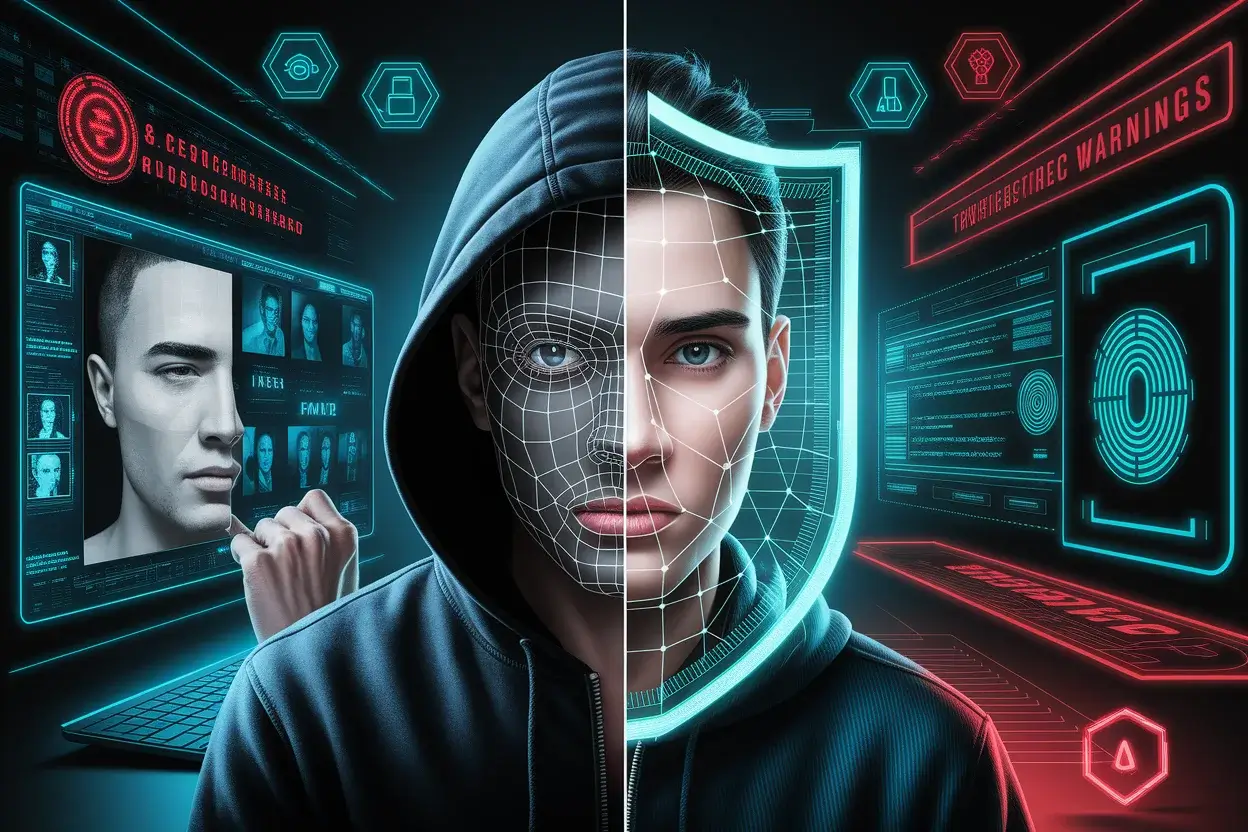Introduction: The Dark Side of Face Search AI
As face search AI technology becomes more sophisticated and accessible, it has opened new frontiers for both legitimate use and malicious exploitation. In 2025, the rise of deepfakes, AI-generated content, and sophisticated identity theft techniques has created unprecedented security challenges that require proactive defense strategies.
Why Face Search Security Matters Now
The convergence of AI advancement and cybercriminal innovation has created a perfect storm of new threats. Face search technology, while beneficial for legitimate purposes, can be weaponized for surveillance, harassment, and fraud.
- Deepfakes becoming indistinguishable from real content
- Identity theft using publicly available photos
- Corporate espionage through facial recognition
- Social engineering attacks using AI-generated personas
Current Threat Landscape in 2025
The security threat landscape has evolved dramatically with the democratization of AI tools. What once required significant technical expertise can now be accomplished with consumer-grade applications and minimal training.
Synthetic Identity Creation
Criminals create entirely fake identities using AI-generated faces that don't correspond to real people.
Financial Fraud
Deepfake videos and photos used to bypass biometric authentication systems in banking and finance.
Romance Scams 2.0
AI-generated profiles with consistent photos and videos used for sophisticated catfishing operations.
Corporate Infiltration
Fake employee profiles created to gain insider access to corporate systems and information.
Political Manipulation
Deepfake content used to spread misinformation or damage reputations during critical events.
Surveillance Evasion
Criminals using face-swapping technology to evade security cameras and facial recognition systems.
Understanding Deepfake Threats
Deepfake technology has reached a concerning level of sophistication in 2025. Modern deepfakes can be created in real-time with minimal source material and are becoming increasingly difficult to detect without specialized tools.
Types of Deepfake Attacks
Video Deepfakes
- • Real-time face swapping in video calls
- • CEO fraud via fake video messages
- • Non-consensual intimate imagery
- • Political disinformation campaigns
Photo Deepfakes
- • Fake profile pictures for social media
- • Document fraud with AI-generated faces
- • Synthetic training data poisoning
- • Identity verification bypass
Modern Identity Theft Methods
Face search AI has enabled new forms of identity theft that go beyond traditional methods. Criminals can now create convincing digital personas and exploit them across multiple platforms simultaneously.
Harvesting photos from public profiles for identity creation
Creating fake profiles using stolen or generated photos
Fake LinkedIn profiles for corporate espionage
Using deepfakes to defeat KYC verification
Mixed resolution or lighting across profile photos
Account with few photos or recent creation date
Avoiding video calls or real-time verification
Vague or inconsistent personal information
Advanced Detection Techniques
As deepfakes become more sophisticated, detection methods must evolve accordingly. Modern detection techniques combine multiple approaches including technical analysis, behavioral patterns, and metadata examination.
Technical Detection Methods
Temporal Analysis
Examining frame-to-frame consistency and temporal artifacts that indicate artificial generation.
- • Frame blending inconsistencies
- • Unnatural motion patterns
- • Temporal flickering artifacts
Facial Landmark Analysis
Analyzing facial feature positioning and movement patterns for biological accuracy.
- • Eye movement synchronization
- • Micro-expression authenticity
- • Facial geometry consistency
Compression Artifacts
Detecting compression patterns that indicate AI generation or manipulation.
- • JPEG compression anomalies
- • Neural network artifacts
- • Frequency domain analysis
Biometric Inconsistencies
Identifying violations of biological constraints in facial features and expressions.
- • Impossible facial proportions
- • Unnatural aging patterns
- • Inconsistent lighting physics
Detection Tools and Resources
AI-Powered Detection Services
Commercial deepfake detection APIs that can be integrated into applications for real-time analysis.
Blockchain Verification
Content authenticity systems that create immutable records of original media creation.
Metadata Analysis Tools
Software that examines EXIF data, creation timestamps, and device signatures for authenticity verification.
Comprehensive Protection Strategies
Enterprise Security Framework
Organizations face unique challenges from deepfake and identity theft attacks. A comprehensive security framework must address both technical and human factors to effectively protect against these evolving threats.
Multi-Layer Defense Strategy
Technical Controls
- • Real-time deepfake detection systems
- • Biometric authentication redundancy
- • Content provenance tracking
- • AI-powered threat monitoring
Process Controls
- • Multi-factor identity verification
- • Human verification protocols
- • Incident response procedures
- • Regular security assessments
Human Controls
- • Employee awareness training
- • Social engineering resistance
- • Reporting mechanisms
- • Cultural security mindset
Preparing for Future Threats
The threat landscape will continue evolving as AI technology advances. Staying ahead requires understanding emerging trends and preparing defensive strategies for future attack vectors.
Emerging Threat Vectors
Next-Generation Deepfakes
- • Real-time video generation
- • Voice and facial synthesis integration
- • Cross-platform consistency
- • Minimal training data requirements
Advanced Attack Methods
- • AI-powered social engineering
- • Automated identity farming
- • Deepfake-as-a-Service platforms
- • Quantum-resistant falsification
